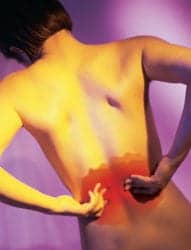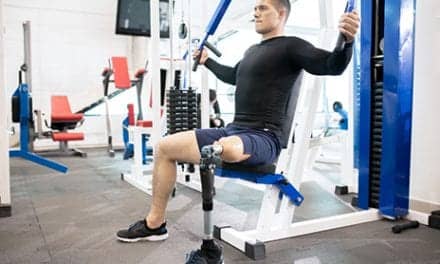Those who suffer chronic back pain after an injury find their lives transformed as routines become fragmented and relationships are disrupted by lingering discomfort. The diagnosis, usually for life, casts treatment as management. And though management is never a cure, it supplies a set of tools that can enable patients not so much to ignore their pain but rather to be less impressed by it and able to remodel their quality of life.
“By the time you’re ready to accept management, you’ve already been through a lot of treatments that haven’t worked,” Melanie Swan, ORT/L, says. Swan is the clinical manager of the Chronic Pain Care Center at the Rehabilitation Institute of Chicago (RIC), a multidisciplinary facility accustomed to treating patients who wandered too long searching for a cure that did not exist.

“If your physician came to you and said you would have chronic pain the rest of your life, would you take that at face value and go directly to a chronic pain treatment facility? Or would you go somewhere else and get a second opinion, or a third opinion?
“It’s a lot to swallow,” Swan says.
Though RIC is the last stop on the train for some patients, Swan says it is the right destination for those who have divested themselves of medical interventions and embraced an approach that deals realistically with the condition.
The philosophy of managing pain at RIC is firmly rooted in education, something Swan admits appears deceptively simple on the outside, yet is structured to yield dividends through the long term.
“We teach skills patients can apply to their daily lives that can create an overall decrease in their dependence on the medical system,” Swan says. Patients are taught to understand the anatomy and physiology associated with their condition and how to dose and progress their own exercises.
“Patients seek services from a physician or PT or chiropractor only when they truly need them and are able to self-manage their pain in the interim,” Swan says.
The therapy mix can include relaxation techniques, core strengthening, and exercises that increase range of motion and flexibility. A staff psychologist is also available to tailor coping skills designed to ease the changes a patient may encounter in lifestyle, leisure activities, and family interaction.
Individuals who suffer chronic back pain occupy up to 30% of the patient roster at RIC, Swan estimates. RIC therapist Amie King, PT, says the majority of that population comprises patients dealing with pain as a result of workplace injuries and insidious onset. King says overuse injuries dominate the back pain subset and usually stem from poor posture coupled with poor body mechanics. Disk pathology, she says, is usually present and precipitates a parade of symptoms that include back pain, sacroiliac joint pain, hip pain, radicular pain, paresthesia, and numbness.
“Our typical patient is one who colors in a good portion of the body chart,” King says, “not just a specific point of lower or upper back pain.”
Aquatic therapy, King says, is one of the most helpful treatments available to physical therapists, and is particularly useful for therapists who work with overweight patients. The free movement provided by buoyancy allows patients to work on new activation and movement patterns as well as build strength that can be used on dry land.
King does not endorse any single measure as a silver bullet for treating chronic back pain but contends a combination of education, lumbar stabilization, and active exercises to remodel tissue are the most effective approaches to treatment.
Modalities such as ultrasound, hot/cold therapy, and electric stimulation, King says, have proved to be of little benefit in the RIC regimen. King says that since tissue itself is not the sole issue in chronic back pain cases, spending treatment time with such modalities is minimally justified.
GETTING A BUY-IN
Pain and fear are rarely far apart from each other, and it is the fear of pain that can make chronic back pain suffers stop just short of the clinic’s front door.
“We tell them we’re going to help them change their lives, and they’re fearful to even hope for that,” Swan says. “Because what if it doesn’t work? Then it’s just one more disappointment in a string of things they thought would work and didn’t.”
King believes satisfactory outcomes are more related to an individual’s motivation than any specific diagnosis or cause of pain. She adds that patients who enter the RIC program with leftover skepticism from previous, unsuccessful treatments that only increased their pain sometimes fear they will only find more of the same.
“Being a physical therapist in a chronic pain setting requires a lot of patience and willingness to take the time to address the psychosocial issues a patient is dealing with, and not just treat the physical symptoms,” King explains. “It is a balance of treating the whole person.
“The patient’s state of mind has everything to do with how effective a treatment session will be,” King says.
Chronic pain makes chemical and physical changes on the body, King explains, and those changes demand adjustments in behavior from patients who want to reap greater rewards from their pain-management program. To successfully cope with the pain-induced physiological changes, King says patients must alter their behavior from the way they tie their shoes to the way they think about the pain itself.
“Patients willing to make the changes have more successful outcomes regardless of their diagnosis or mechanism of injury,” King says.
UNDER THE SKIN
Orthopedic surgeon Mark Wolgin, MD, understands the resignation felt by some of the chronic back pain patients who enter his Albany, Ga, practice (www.drwolgin.com), hoping for a respite.
“Most patients want to walk in the room, put their pain on the table, and say, ‘Here you go, doc. You take care of it. I’m going to be in the waiting room.'”
Wolgin, who completed a fellowship in spinal surgery at Cedars-Sinai Medical Center, Los Angeles, does not generally rush patients complaining of back pain toward a surgical intervention. Instead, he begins with conservative interventions that include medication, exercise, and physical therapy. The decision to advance treatment to a higher level is always left to the patient, and choosing a surgical option is a decision driven by how well a person deals with a particular level of discomfort.
“With surgery, you’re going to get one of three results: You’re going to get better, stay the same, or get worse. And the chance of getting worse is not zero, so patients need to have all the facts about the procedure and make an informed decision.”
Using surgery as an intervention to alleviate pain caused by a herniated disk is not uncommon for Wolgin, who points out that simply lifting grocery bags can cause a disk herniation. The condition can produce abrupt, intense back pain. Even in these cases, however, Wolgin says surgery is not a foregone conclusion.
“By the medical literature, there is an 80% to 90% chance you will get better in about 6 weeks if you just tough it out: take the medicine, do the exercises, and whatever you can to get going.
“But it’s 6 weeks, not 2 days.
“If you had 2 days of pressure on a nerve that caused terrible pain down your leg, you’d almost sign up for anything. You can do a minimally invasive discectomy with a little incision; you wake up, and your pain is gone.”
Spinal fusion is another common surgical intervention Wolgin uses to treat chronic back pain, and while he does not consider it a panacea for treating the condition, he says if it is the right treatment for the right problem, it can help. The pain relief spinal fusion provides, Wolgin cautions, must be considered against the probability a patient who undergoes the procedure will experience adjacent-level degeneration at some point.
“If you fuse one spinal segment, it’s going to put more stress on the other ones over the course of years and eventually wear out. A person might say they feel great at first, but talk to them in 5 years and chances are pretty good—more than a coin flip—you’re going to get a different answer.”
Delaying treatment for chronic back pain can be risky as well. Wolgin explains that a herniated disk can put pressure on a nerve root that can cause partial paralysis of muscles in the leg for lumbar disks, or the arm for cervical disks. Left untreated, this paralysis can become permanent. In such cases, the longer the treatment is delayed, the lower the chance of regaining function.
Once a patient’s fusion procedure appears successful, Wolgin is likely to look to a rehabilitation program that includes walking, swimming, stationary bicycles, and general conditioning programs. He credits passive modalities with helping patients feel better during their recoveries, but says substantive, lasting effects derive from active, exercise-related programs that include core strengthening and gentle stretching.
CHANGING PERCEPTIONS ABOUT PAIN
Back at RIC, Swan observes that public attitudes about chronic pain, in general, are changing. The shift, she says, is related to the better understanding science has developed of how pain affects the body and the brain’s response to pain stimuli.
“It’s more acceptable now to talk about having pain,” Swan says. “In the past, people would expect an injured person to have pain for a certain period of time and then expect them to ‘suck it up’ and get back to life.”
The tide is turning even for insurance companies, often the barometer of what constitutes “medically necessary” treatment. “They’re saying, ‘OK, this is more expensive up front, but what is the outcome?’ “I think health insurance firms are beginning to realize that programs like ours have a great value over time,” Swan says, “and are seeing them as the responsible way to handle a patient’s pain-management care over the long run.”
Frank Long is the associate editor of Rehab Management. For more information, contact .





